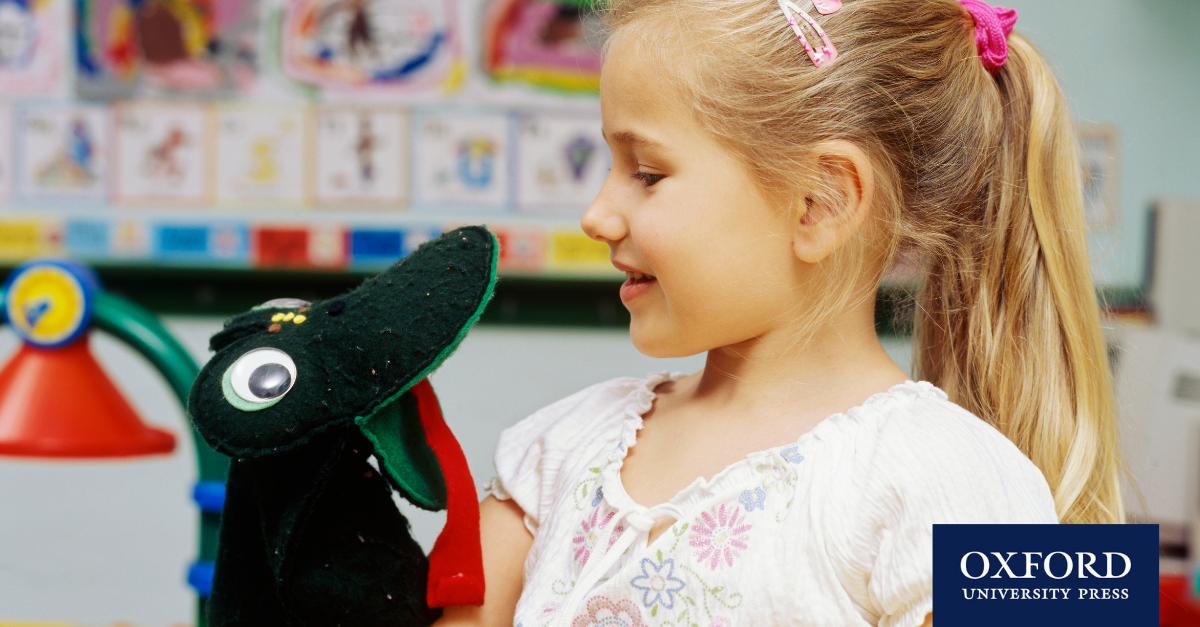 Enter the world of a young child. What might you discover? Young children squeal with delight at surprises. They love to use their imaginations. They easily become animals, princesses, firefighters, doctors, and more! How can we as English teachers build English language skills while nurturing our young learners’ creativity and imaginations? Let’s explore some classroom strategies and activities that successful teachers of young learners use.
Enter the world of a young child. What might you discover? Young children squeal with delight at surprises. They love to use their imaginations. They easily become animals, princesses, firefighters, doctors, and more! How can we as English teachers build English language skills while nurturing our young learners’ creativity and imaginations? Let’s explore some classroom strategies and activities that successful teachers of young learners use.
1. Classroom songs and chants
Listen to a classroom of young learners. Songs and chants can be heard throughout the day. Let’s consider using a song for a warm-up activity. What kinds of songs or chants work best with young learners? One of the things I look for in a song or chant is a simple pattern. For example, consider this well-known children’s game song, “Looby Loo.”
Here we go Looby Loo. Here we go Looby Light.
Here we go Looby Loo, all on a Saturday night.
We put our hands in. We put our hands out.
We give our hands a shake, shake, shake,
and turn ourselves about, OH!
In this song, the children hold hands while walking around in a circle. For my Japanese students, the song gets their ears ready to hear the /l/ sound that’s not present in their language. The song is cheerful and uses movement that gets children’s bodies warmed up for class.
After children have learned a song, patterns invite them to add their own ideas. What can we change? We could focus on body parts. Children enjoying thinking of a new body part with each repetition. To guide thinking, you can give a child a bilateral choice: Should we move our legs (move your legs) or our fingers (wiggle your fingers)? After a few repetitions, children may be able to name a body part independently.
Sing the song at the next class but add something new. We could change the way we “go” around the circle. Children choose new verbs, such as jump, hop, march, tiptoe, run, skip, gallop, etc. Make it more interesting by changing your voice, speeding up the song, or slowing it down.
Giving children choices nurtures their creativity and encourages output.
2. Creative movement
As I mentioned with music, young learners love to move. There are so many ways that we can add movement to our classes for children.
TPR (Total Physical Response) invites children to respond to movement commands. Using movement in a song as mentioned above is similar. Students hear the words, watch the movement, and move to the words.
Some movements are easy to do in one place, such as clap your hands, pat your legs, stomp your feet, touch your toes, wave your arms, wiggle your fingers, nod your head, blink your eyes, shake your hair, bend your knees. Some movements can be done around a circle or in an open classroom space, like the ones mentioned in Looby Loo.
Children can use their imaginations to move in so many different ways. They can pretend to be animals, Halloween characters, or their favourite storybook character. Using simple props makes it even more interesting.
3. Puppets and stuffed animals
Engage your children’s imaginations by making puppets or stuffed animals a regular part of your English lessons. Practice in front of a mirror to make your puppet appear more life-like. I just introduced my new hedgehog puppet to my kindergarten class. I invited my students to give him a name. They chose “Harry.” Harry comes to class every week. Your puppets can lead an activity, join in a game, read a book, or be part of a conversation. They are often just what you need for your shy students.
4. Hands-on classroom learning
What else can we bring into our young learner classroom? Use your imagination! Real items can be used in numerous ways. Thinking of unusual ways to use items makes learning fun while nurturing your students’ creative thinking.
For example, beanbags can be used to practice colours and play games, but we can use them for imaginative chants, too. Scarves can be used to toss in the air. Pretend that they are leaves, a flower, or the wings of a butterfly. Asking yourself if there’s another way to do something will lead you to new creative choices.
5. Books
Children’s stories can be used in many ways with young learners. Most children’s books have beautiful illustrations, a perfect tool for teaching new vocabulary. Board books often have some type of interactive features that make reading even more interesting.
Come and discover the magic!
In my webinar, I shared strategies and activities that you’ll be able to use immediately in your very young learner classroom. I modelled ways in which you can enter the world of imagination and develop language. Join me for an active session of songs, chants, creative movement, puppets, scarves, beanbags, children’s stories, and more!
Kathleen Kampa specializes in working with young learners. As a PYP (Primary Years Program) teacher, she uses an inquiry-based approach to teaching through which students develop 21st Century skills. Kathleen uses multiple intelligences strategies to help all students find success. She also builds English language skills by creating songs, chants, and movement activities targeted to children’s needs. Kathleen and her husband Charles Vilina are co-authors of Magic Time, Everybody Up, and the ELTon award-winning course, Oxford Discover, published by Oxford University Press.


thank you for the article